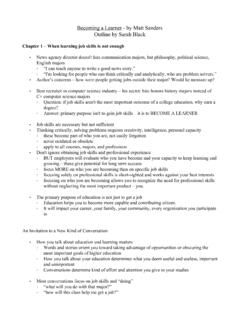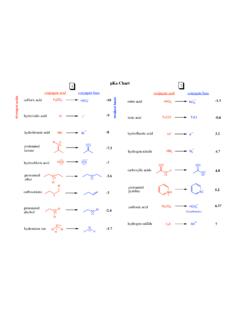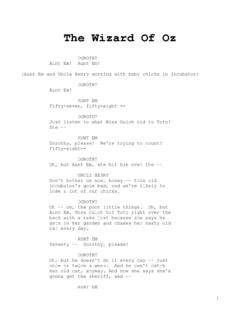Transcription of Hugh Rockoff of Rutgers University, ‘The “Wizard of …
1 Hugh Rockoff of Rutgers University, the wizard of Oz as a monetary allegory , journal of political economy , Vol. 98, 1990, pp. 739-760. I. Introduction the wizard of Oz is perhaps the best-loved American children's story. The movie, starring Judy Garland, Bert Lahr, Ray Bolger and company, is an annual television ritual. The book on which the movie is based, L. Frank Baum's The Wonderful Wizard of Oz, however, is not only a child's tale but also a sophisticated commentary on the political and economic debates of the Populist Previous interpretations have focused on the political and social aspects of the allegory . The most important of these is Littlefield ([1966] 1968), although his interpretation was adumbrated by Nye (1951), Gardner and Nye (1957), Sackett (I960), and Bewley ([1964] 1970). My purpose is to unlock the references in the wizard of Oz to the monetary debates of the 1890s. When the story is viewed in this light, the real reason the Cowardly Lion fell asleep in the field of poppies, the identity of the wizard of Oz, the significance of the strange number of hallways and rooms in the Emerald Palace, and the reason the Wicked Witch of the West was so happy to get one of Dorothy's shoes become clear.
2 Thus interpreted, the wizard of Oz becomes a powerful pedagogic device. Few students of money and banking or economic history will forget the battle between the advocates of free silver and the defenders of the gold standard when it is explained through the wizard of Oz. This paper also serves a more conventional purpose. William Jennings Bryan and his supporters in the free silver movement, who play a central role in the story, have been treated as monetary cranks even by historians who are sympathetic to them on other Here I show that Bryan's monetary thought was surprisingly sophisticated and that on most issues his positions, in the light of modern monetary theory, compare favorably with those of his "sound money" L. Frank Baum's early life proved to be ideal preparation for writing a monetary Born to a wealthy family in Chittenango, New York, in 1856, Baum while still in his early 20s wrote and produced a successful play that made it to Broadway. In 1882 he married Maud Gage, the daughter of one of the leading suffragettes, Matilda Joslyn Gage.
3 Later Baum and his family moved to Aberdeen, South Dakota, where he viewed at close hand the frontier life that gave rise to the populist movement. He was unsuccessful in South Dakota, where among other things he published a small paper, the Saturday Pioneer, and several issues of the Western Investor. In 1890, the Baums moved to Chicago. While pursuing a number of jobs, he frequented the Chicago Press Club and met some of the city's leading writers. There he undoubtedly heard a great deal about the battle for the free coinage of silver, especially in 1896 when Chicago hosted the Democratic National Convention at which William Jennings Bryan made his famous "Cross of Gold" speech. Baum's first book of children's stories was published in 1897 and, in 1900, The Wonderful Wizard of Oz followed. After moving to Hollywood, Baum devoted himself to writing children's stories, the most successful being sequels to his masterpiece. Table I contains data basic to an understanding of the world that produced the wizard of Oz.
4 The key fact was deflation. The gross national product deflator, shown in column 1, fell steadily from the end of the 1860s until the United States returned to the gold standard in 1879. After a brief upsurge the deflator resumed its fall, reaching its nadir in 1896. Farm prices, shown in column 2, fell even more 1 What follows is based on the book. Metro-Goldwyn-Mayer made numerous changes in the text, some of which, such as changing the silver slippers of the book into the famous ruby slippers of the movie, obscure the allegory . 2 For the purposes of this paper, it is sufficient to lump the Populists, free silver Democrats, and other supporters of free silver together. But it should be noted that while the Populist party nominated Bryan, many hard-line Populists advocated more radical measures such as greenbacks or a commodity-backed currency and supported free silver only as the best that could be gotten in the current political climate.
5 See Goodwyn (I976) and the appendix by Yohe (I976) for a detailed discussion of populist monetary ideas and their relationship to free silver. 3 There are many biographies of Bryan. Two of the best, on the issues covered here, are Coletta (1964-69) and Koenig (1971). 4 This paragraph is based on Baum and MacFall (1961), the major biography of L. Frank Baum. 2 rapidly, also reaching a post-Civil War low in 1896. Thus part of the farm problem was the decline in the relative price of farm products. It is a fair criticism of the Populists, to which Bryan is not immune, that they did not adequately distinguish between general price trends that resulted from relatively slow growth in the stock of money compared with real output and relative price trends that would be impervious to monetary Between 1869 and 1879 the stock of money grew at about percent per year and real output at about percent per year, so the deflationary pressure from the lack of monetary growth is easy to understand.
6 In the same period, high-powered money-gold and silver moneys, other Treasury obligations that could serve as bank reserves, and national bank notes6 increased at a rate of only percent per year, so the deflation can be traced ultimately to the slow growth in high-powered money. In the following decade, however, the story is somewhat different. High-powered money actually grew at percent per year and the total money stock at percent, while the rate of growth of real income slowed to percent. Since the United States was linked after 1879 to other gold standard countries by fixed exchange rates, one might expect, on the basis of the actual money and real income figures and the velocity trend in the previous decade, a high inflation rate paralleled by inflation in other gold standard countries. Otherwise rapid monetary growth would have been cut short by an outflow of gold. But instead all that happened during the 1880s was a leveling off of prices: the rate of deflation declined from - percent per year in the 1870s to a modest - 0.
7 I percent per year in the 1880s. In other words, after falling at the relatively low rate of percent per year in the 1870s, velocity fell a surprising , percent per year in the 1880s. The 1880s were a period perhaps something like the 1980s, in which the economy exhibited a surprisingly strong demand for additional money balances. It would take us too far afield to attempt an explanation of this phenomenon. Suffice it to say that in the 1880s as in the 1980s, there are a number of candidate explanations: interest rates were falling, partially reflecting the fall in prices, but perhaps for other reasons as well; and institutional developments such as the rapid development of the state banking systems may have played a role. The Panic of 1893 and the subsequent depression were superimposed on these long-term price trends. The depression shows up dramatically in the unemployment data in column 4. Although there is a wide margin of error, it appears that unemployment exploded from 3 percent in 1892 to percent in 1893, peaking at percent in 1894.
8 The exact cause of the panic is in doubt. One factor was concern over maintenance of the gold standard. In 1890, Congress had passed the Sherman Silver Purchase Act, which provided for the regular purchasing and coining of silver in limited quantities. Silver had been purchased under earlier legislation, but Sherman's act increased the amount. Along with other proposed legislation, it stimulated fears that the United States might leave the gold standard, and this led to a depletion of Treasury gold stocks. In addition depletion of Treasury gold stocks. In addition, there was a stock market crash prompted by several business failures and a growing tide of bank failures, particularly in the West. Together these developments produced a banking panic, the suspension of gold payments, and a severe depression of an order not seen since the 1830s and not to be seen again until the 1930s. The response of President Grover Cleveland was to seek (successfully) the repeal of the Sherman Silver Purchase Act.
9 But a brief cyclical expansion that began in June 1894 petered out, the peak coming in December 1895. According to Friedman and Schwartz (1963, p. III), it was one of the weakest expansions in the cyclical history of the United States. When the Democrats met at Chicago in the summer of 1896 to nominate a candidate for president, the economy , to put it mildly, was in terrible shape 5 Harvey ((18941 1963, pp. 198-214), , illustrates the deflation with series on wheat, cotton, and silver. Then in answering the criticism that prices other than wheat had fallen by an equal percentage, he points first to debts but then (p. 214) to a variety of prices-streetcar fares, a hotel room, and so on-that were not fixed in nominal terms. 6 The inclusion of national bank notes in high-powered money is debatable since they were a liability of commercial banks analogous to deposits. But Milton Friedman and Anna Schwartz (who developed the basic series) included the notes in high-powered money, basing their decision on several considerations.)
10 The most important was simply that national bank notes were indirectly obligations of the federal government since they had to be backed by federal government bonds. 3and apparently was getting worse. The closest parallel, perhaps, is with 1932. Unemployment was percent. This was one of the most famous conventions in American history. The Democrats were locked in a battle between those favoring the gold standard and those favoring a bimetallic standard. After numerous votes, they finally nominated William Jennings Bryan. He and his supporters called for the free and unlimited coinage of silver at mint prices that made the value of 16 ounces of silver equivalent to I ounce of gold. As can be seen in column 3 of table 1, this ratio was far below the ratio then prevailing in the market, about 31 to 1. Had the United States returned to a bimetallic standard at 16 to 1, there probably would have been some outflows of gold and inflows of silver, although the exact amount is hard to quantify.
















